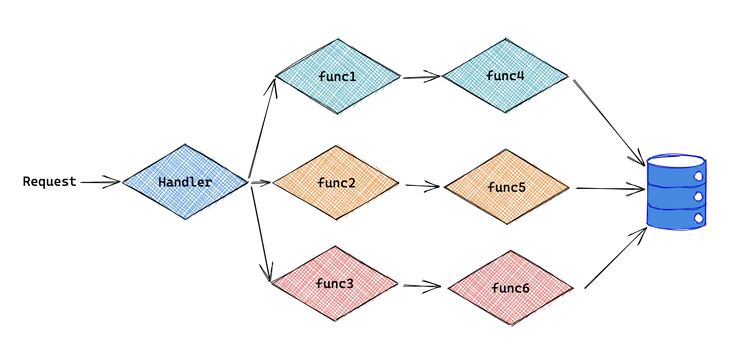为什么需要超时控制?
- 请求时间过长,用户侧可能已经离开本页面了,服务端还在消耗资源处理,得到的结果没有意义
- 过长时间的服务端处理会占用过多资源,导致并发能力下降,甚至出现不可用事故
Go 超时控制必要性
Go 正常都是用来写后端服务的,一般一个请求是由多个串行或并行的子任务来完成的,每个子任务可能是另外的内部请求,那么当这个请求超时的时候,我们就需要快速返回,释放占用的资源,比如goroutine,文件描述符等。

服务端常见的超时控制
- 进程内的逻辑处理
- 读写客户端请求,比如HTTP或者RPC请求
- 调用其它服务端请求,包括调用RPC或者访问DB等
没有超时控制会怎样?
为了简化本文,我们以一个请求函数 hardWork 为例,用来做啥的不重要,顾名思义,可能处理起来比较慢。
func hardWork(job interface{}) error {
time.Sleep(time.Minute)
return nil
}
func requestWork(ctx context.Context, job interface{}) error {
return hardWork(job)
}
这时客户端看到的就一直是大家熟悉的画面
<img src="https://gitee.com/kevwan/static/raw/master/doc/images/loading.jpg" width="25%">
绝大部分用户都不会看一分钟菊花,早早弃你而去,空留了整个调用链路上一堆资源的占用,本文不究其它细节,只聚焦超时实现。
下面我们看看该怎么来实现超时,其中会有哪些坑。
第一版实现
大家可以先不往下看,自己试着想想该怎么实现这个函数的超时,第一次尝试:
func requestWork(ctx context.Context, job interface{}) error {
ctx, cancel := context.WithTimeout(ctx, time.Second*2)
defer cancel()
done := make(chan error)
go func() {
done <- hardWork(job)
}()
select {
case err := <-done:
return err
case <-ctx.Done():
return ctx.Err()
}
}
我们写个 main 函数测试一下
func main() {
const total = 1000
var wg sync.WaitGroup
wg.Add(total)
now := time.Now()
for i := 0; i < total; i++ {
go func() {
defer wg.Done()
requestWork(context.Background(), "any")
}()
}
wg.Wait()
fmt.Println("elapsed:", time.Since(now))
}
跑一下试试效果
➜ go run timeout.go
elapsed: 2.005725931s
超时已经生效。但这样就搞定了吗?
goroutine 泄露
让我们在main函数末尾加一行代码看看执行完有多少goroutine
time.Sleep(time.Minute*2)
fmt.Println("number of goroutines:", runtime.NumGoroutine())
sleep 2分钟是为了等待所有任务结束,然后我们打印一下当前goroutine数量。让我们执行一下看看结果
➜ go run timeout.go
elapsed: 2.005725931s
number of goroutines: 1001
goroutine泄露了,让我们看看为啥会这样呢?首先,requestWork 函数在2秒钟超时后就退出了,一旦 requestWork 函数退出,那么 done channel 就没有goroutine接收了,等到执行 done <- hardWork(job) 这行代码的时候就会一直卡着写不进去,导致每个超时的请求都会一直占用掉一个goroutine,这是一个很大的bug,等到资源耗尽的时候整个服务就失去响应了。
那么怎么fix呢?其实也很简单,只要 make chan 的时候把 buffer size 设为1,如下:
done := make(chan error, 1)
这样就可以让 done <- hardWork(job) 不管在是否超时都能写入而不卡住goroutine。此时可能有人会问如果这时写入一个已经没goroutine接收的channel会不会有问题,在Go里面channel不像我们常见的文件描述符一样,不是必须关闭的,只是个对象而已,close(channel) 只是用来告诉接收者没有东西要写了,没有其它用途。
改完这一行代码我们再测试一遍:
➜ go run timeout.go
elapsed: 2.005655146s
number of goroutines: 1
goroutine泄露问题解决了!
panic 无法捕获
让我们把 hardWork 函数实现改成
修改 main 函数加上捕获异常的代码如下:
go func() {
defer func() {
if p := recover(); p != nil {
fmt.Println("oops, panic")
}
}()
defer wg.Done()
requestWork(context.Background(), "any")
}()
此时执行一下就会发现panic是无法被捕获的,原因是因为在 requestWork 内部起的goroutine里产生的panic其它goroutine无法捕获。
解决方法是在 requestWork 里加上 panicChan 来处理,同样,需要 panicChan 的 buffer size 为1,如下:
func requestWork(ctx context.Context, job interface{}) error {
ctx, cancel := context.WithTimeout(ctx, time.Second*2)
defer cancel()
done := make(chan error, 1)
panicChan := make(chan interface{}, 1)
go func() {
defer func() {
if p := recover(); p != nil {
panicChan <- p
}
}()
done <- hardWork(job)
}()
select {
case err := <-done:
return err
case p := <-panicChan:
panic(p)
case <-ctx.Done():
return ctx.Err()
}
}
改完就可以在 requestWork 的调用方处理 panic 了。
超时时长一定对吗?
上面的 requestWork 实现忽略了传入的 ctx 参数,如果 ctx 已有超时设置,我们一定要关注此传入的超时是不是小于这里给的2秒,如果小于,就需要用传入的超时,go-zero/core/contextx 已经提供了方法帮我们一行代码搞定,只需修改如下:
ctx, cancel := contextx.ShrinkDeadline(ctx, time.Second*2)
Data race
这里 requestWork 只是返回了一个 error 参数,如果需要返回多个参数,那么我们就需要注意 data race,此时可以通过锁来解决,具体实现参考 go-zero/zrpc/internal/serverinterceptors/timeoutinterceptor.go,这里不做赘述。
完整示例
package main
import (
"context"
"fmt"
"runtime"
"sync"
"time"
"github.com/tal-tech/go-zero/core/contextx"
)
func hardWork(job interface{}) error {
time.Sleep(time.Second * 10)
return nil
}
func requestWork(ctx context.Context, job interface{}) error {
ctx, cancel := contextx.ShrinkDeadline(ctx, time.Second*2)
defer cancel()
done := make(chan error, 1)
panicChan := make(chan interface{}, 1)
go func() {
defer func() {
if p := recover(); p != nil {
panicChan <- p
}
}()
done <- hardWork(job)
}()
select {
case err := <-done:
return err
case p := <-panicChan:
panic(p)
case <-ctx.Done():
return ctx.Err()
}
}
func main() {
const total = 10
var wg sync.WaitGroup
wg.Add(total)
now := time.Now()
for i := 0; i < total; i++ {
go func() {
defer func() {
if p := recover(); p != nil {
fmt.Println("oops, panic")
}
}()
defer wg.Done()
requestWork(context.Background(), "any")
}()
}
wg.Wait()
fmt.Println("elapsed:", time.Since(now))
time.Sleep(time.Second * 20)
fmt.Println("number of goroutines:", runtime.NumGoroutine())
}
更多细节
请参考 go-zero 源码:
- go-zero/core/fx/timeout.go
- go-zero/zrpc/internal/clientinterceptors/timeoutinterceptor.go
- go-zero/zrpc/internal/serverinterceptors/timeoutinterceptor.go
项目地址
https://github.com/tal-tech/go-zero
js


